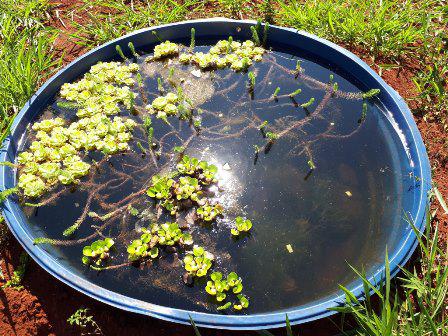Victor Satoru Saito
Water resources and freshwater biodiversity are being highly threatened by agriculture expansion, including sugar cane plantations in Southeast Brazil. In this sense, we do not fully understand the possible impacts of agriculture contaminants on higher levels of ecological organization such as entire communities and on ecosystem processes, which maintain services for humanity. We aim to conduct reservoir samplings, as well as mesocosm experimentation to obtain robust information on how important contaminants affect the aquatic biodiversity of communities and how this, in turn, could impact the functioning of the entire ecosystem. Our study will be able to provide information that could be directly used to police agriculture practices in ways that protects water quality, as well as aquatic biodiversity.

An experimental mesocosm model ecosystems to understand the impacts of agriculture contaminants on aquatic biodiversity and water quality. ©Victor Satoru Saito.
Continental aquatic environments harbour disproportionately high species diversity for the land area it occupies. These environments occupy only 0.01% of the planet, however, lakes and streams, harbour 10% of the animal species described so far. Among the biodiversity from aquatic systems, we highlight the zooplankton community, which is a key link between producers and higher levels and are important controllers of water eutrophication. The habitats of zooplankton communities (lakes and reservoirs) are highly threatened due to agricultural intensification, including the sugar cane plantation in Brazil.
Agriculture contaminants can impact aquatic biodiversity in a variety of ways since any compound used throughout the agricultural production can have as its final destination some water body due to the natural configuration of river basins. The impacts of the contaminants, such as fertilizers and pesticides, are well studied using traditional ecotoxicological approach, but at higher ecological levels, such as communities and ecosystems, our knowledge is still incipient. Among the contaminants, we highlight pesticides and sugar cane vinasse, which are two common contaminants that should cause very distinct impacts on aquatic systems.
Our project will seek evidence about the possible differential impacts of vinasse and pesticides on zooplankton diversity, which in turn should affect ecosystem functioning in different ways. The study will encompass samplings in lentic systems in the São Paulo State, as well as mesocosm experimentation. The region has a natural vegetation of Cerrado and Atlantic Forest and encompasses several human-made reservoirs with high importance for water supply in the whole region. The understanding of how agriculture contaminants may impact these systems is thus pivotal to forecast impacts not only on biodiversity, but also in water supply.
This project will provide results that can have practical use in conservation and management of aquatic biodiversity and water use. We will have replicated and controlled results about the individual impacts of vinasse and pesticides on community composition of zooplankton that could be used to drive policy-making strategies to avoid impacts, as well as could be used to improve discarding practices. Moreover, we will have evidence of impacts to the whole metabolism of an ecosystem which is pivotal to forecast changes in nutrient cycling and loss of water quality. The information generated by this project could be directly used to police agriculture practices in ways that protects water quality, as well as aquatic biodiversity.